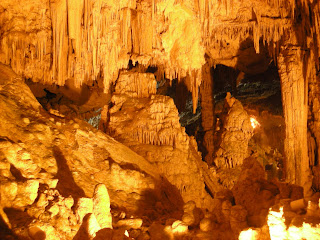 Just before we arrived in Santa Teresa di Gallura, we stopped at Spiaggia Rena Maggiore, the beach on the windy west side of Capo Testa. The water was pretty rough and it was a bit early in the day so we didn't go in and hopped back in the car to continue towards the city.
Just before we arrived in Santa Teresa di Gallura, we stopped at Spiaggia Rena Maggiore, the beach on the windy west side of Capo Testa. The water was pretty rough and it was a bit early in the day so we didn't go in and hopped back in the car to continue towards the city.
Santa Teresa di Gallura, a small colorful fishing village on the northeast tip of Sardinia, was inhabited in Roman times and later made important by the Pisans. The current town was built in the 1800s during the Savoy period of rule. We parked Smurfette, trusting she'd look after our worldly possessions for the day, and headed into town. We came upon this charming block and pizzeria just up the hill from the beach and decided to carb load for the lazy beach afternoon ahead of us.

Afterwards, we headed down to Spiaggia Rena Bianca, known for its golden, powdery sand and the granite cliffs that surround it and keep the water calm. We followed this little guy down the steps to the beach.

The water reflected various shades of blue and green yet was amazingly clear. Behind us you can see one of the rocky crags that form the cove and the large dark rocks scattered along the soft sandy sea floor.

Casandra went in first, as usual. You can see some of the granite rocks that protect and nearly enclose this cove behind her on the left and Corsica in the distance.

After a couple of hours on the beach, we packed up our gear, anxious to see the nearby Capo Testa, which we'd heard was one of the most impressive capes in Sardinia. As we climbed back up the hill towards town, we snapped this last shot of the cove where you can really see how the rocky arms of the hill wrap around and protect it.

As we walked on the cliffs along the shore towards Capo Testa, we passed two beautiful coves that we weren't how to reach except by boat.
 Here's a close-up of the first one.
Here's a close-up of the first one.And here's the second one.
 Capo Testa is a dramatic jagged promontory at the northern tip (or "head") of Sardinia, connected to the mainland by a thin sandbar that extends off the northern coast. These picture hardly do justice to the massive size and depth of this rocky gorge - we're actually standing on a cliff nearly 1000 feet above sea level!
Capo Testa is a dramatic jagged promontory at the northern tip (or "head") of Sardinia, connected to the mainland by a thin sandbar that extends off the northern coast. These picture hardly do justice to the massive size and depth of this rocky gorge - we're actually standing on a cliff nearly 1000 feet above sea level! It made me feel really really small. This particular portion of the cape was the site of an ancient Roman rock quarry. Here, the Romans mined the granite that was used for many of their impressive architectural feats, including the massive columns of the Pantheon.
It made me feel really really small. This particular portion of the cape was the site of an ancient Roman rock quarry. Here, the Romans mined the granite that was used for many of their impressive architectural feats, including the massive columns of the Pantheon. Here is a close-up of the massive granite rocks with the remains of the Roman settlement on top.
Here is a close-up of the massive granite rocks with the remains of the Roman settlement on top. From this point of Capo Testa, you can see the white cliffs of Bonifacio in Corsica only 7.5 miles to the north.
From this point of Capo Testa, you can see the white cliffs of Bonifacio in Corsica only 7.5 miles to the north.Casandra says only Hawaii has natural beauty that rivals this. I haven't been to Hawaii or seen anything even remotely close. The Emeral Coast, our next destination, is supposed to be amazing but I can't imagine it topping this!








































